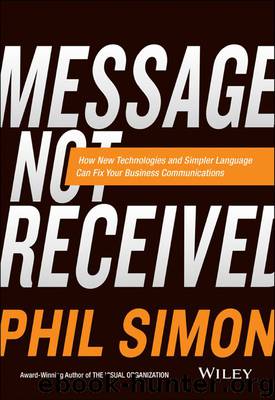Message Not Received: Why Business Communication Is Broken and How to Fix It by Phil Simon

Author:Phil Simon
Language: eng
Format: mobi
ISBN: 9781119048213
Publisher: Wiley
Published: 2015-02-17T14:00:00+00:00
Marie Jesse Type of Relationship Is direct, private communication possible?h
Follows Jesse Does not follow Marie One-way follow No
Does not follow Jesse Follows Marie One-way follow No
Follows Marie Follows Jesse Mutual follow Yes
Does not follow Jesse Does not follow Marie None No
Where does all of this leave e-mail? In two respects, the medium is mostly asynchronous. (I’ll come back to this caveat shortly). This trait has served e-mail very well over the years. First, to send a message requires no Facebook-like mutual opt-in. Gus can send Walt a message even if Walt has never given Gus explicit permission to do so beforehand.i Unsolicited commercial and bulk messages are called spam, but it would be fatuous to equate the terms unsolicited and unwanted. Whether solicited or not, some types of messages are always welcome. Who doesn’t want to receive an unrequested but legitimate sales inquiry?
Note that e-mail isn’t completely asynchronous. IT departments may block certain e-mail domains for different reasons. To this end, many individuals and small businesses use anti-spam products like SPAMfighter Pro and ChoiceMail. Here’s how they work: Based on users’ existing address books and e-mail history, the software automatically creates lists of approved senders (i.e., whitelists). Let’s say that Steve just met Lydia at a networking event. He wants to send her a message, but he’s not on her current whitelist. In this scenario, Steve composes his message and hits the send button. Lydia’s whitelist software ensures that Steve’s message sits in a type of cyber-purgatory unless and until he takes the additional step of authenticating his e-mail address. By pledging that he’s not sending spam, the software releases Steve’s message to Lydia. If Lydia accepts the message, then Steve is automatically added to her whitelist. He need not authenticate his e-mail address again.
A second aspect to e-mail’s asynchronous nature explains its popularity. Consider the telephone for a moment. Let’s say that a telemarketer’s auto-dial software cold calls the Schrader residence. No one picks up, and the machine doesn’t leave a voicemail message. Who would return such a message? The telephone only works in this case if both parties concurrently use it.
Not true with e-mail. (Ignore spam and inboxes that have exceeded their size quotas for the time being.) To be successfully delivered, the sender only needs the recipient’s e-mail address. Unlike the telephone, recipients don’t need to be on a device in order to (eventually) receive it. They don’t need to immediately respond to each message in order for the medium to function. On the contrary, recipients can open and read messages if, whenever, and nowadays wherever they want.
E-mail was not designed to ape the functionality of other communication mediums like online chat rooms and IM applications, although far too many people use it for precisely this purpose. Rather, messages just pile up indefinitely in users’ inboxes. Recipients can receive, read, and send messages when it’s convenient for them. Let’s say that Ted wakes up at 2 a.m. and wants to remind Skyler in accounting to send him the P&L by noon.
Download
This site does not store any files on its server. We only index and link to content provided by other sites. Please contact the content providers to delete copyright contents if any and email us, we'll remove relevant links or contents immediately.
Nudge - Improving Decisions about Health, Wealth, and Happiness by Thaler Sunstein(7525)
Deep Work by Cal Newport(6845)
Principles: Life and Work by Ray Dalio(6165)
Factfulness: Ten Reasons We're Wrong About the World – and Why Things Are Better Than You Think by Hans Rosling(4668)
The Doodle Revolution by Sunni Brown(4657)
Eat That Frog! by Brian Tracy(4406)
Thinking in Bets by Annie Duke(4137)
Hyperfocus by Chris Bailey(4025)
Visual Intelligence by Amy E. Herman(3705)
Writing Your Dissertation in Fifteen Minutes a Day by Joan Bolker(3658)
How to Win Friends and Influence People in the Digital Age by Dale Carnegie & Associates(3481)
Ogilvy on Advertising by David Ogilvy(3480)
Hidden Persuasion: 33 psychological influence techniques in advertising by Marc Andrews & Matthijs van Leeuwen & Rick van Baaren(3444)
How to win friends and influence people by Dale Carnegie(3378)
The Pixar Touch by David A. Price(3342)
Schaum's Quick Guide to Writing Great Short Stories by Margaret Lucke(3299)
Deep Work: Rules for Focused Success in a Distracted World by Cal Newport(3112)
Work Clean by Dan Charnas(3029)
The Slow Fix: Solve Problems, Work Smarter, and Live Better In a World Addicted to Speed by Carl Honore(2929)
